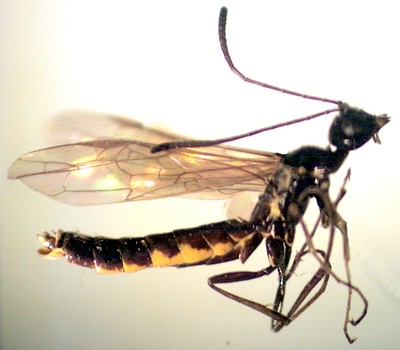Pests
Trachelus tabidus (F.). - Black Sawfly
Systematic position.
Klass Insecta, order Hymenoptera, suborder Symphyta, superfamily Cephoidea, family Cephidae, genus Trachelus.Synonyms.
Cephus nigritus Lep.Biological group.
Pest of grain cereals.Morphology and biology.
Body of imago is black, shining, with yellow-red spots on each side of abdomen, often forming continuous lateral stripes (body length 7-10 mm). Legs black, only tibiae of fore and middle legs more or less yellow from outside. Wings hardly smoky, with red-black pterostigma and veins. Ovipositor sheaths expanded apicad. Larva 10-15 mm in length, yellowish-white, with ocherous head and short antennae. Its body slightly curved in the form of a question mark, with 3 pairs of underdeveloped thoracic legs, without abdominal legs. The larva is very similar to that of Cephus pygmaeus L., differing from the latter in a process on abdominal tip bearing 14-26 spinules in two or three irregular rows. Egg milky-white, elongate-oval. Female lays 30-50 eggs, placing them one by one inside stalks of cereal plants, but more often inside upper internodes. Duration of embrional development is 6-8 days; development of larva lasts 20-40 days depending on regional weather conditions. Finishing feeding, larvae of the last instar winter in transparent cocoons inside stalk hollows. Pupation occurs in April - first half of June, the stage of pupa lasts 7-10 days.Distribution.
The species inhabits Southern, partly Middle and Western Europe (northward to Germany), Asia Minor, Northern Africa (Egypt, Algeria); introduced to Northern America. In the former USSR, it is widespread in the Southwest and South of the European part within the limits of steppe zone, in the Caucasus, in Transcaucasia.Ecology.
Monovoltine species. Its mode of life is similar to that of Cephus pygmaeus. Difference of the two species appears in flight periods; T. tabidus begin to fly 12-20 days after C. pygmaeus which in a steppe zone coincides with the beginning of alfalfa flowering and spring wheat and barley earing. In Stavropol Territory, the flight period of C. pygmaeus is synchronous with appearance of panicle in oats, with the end of winter wheat flowering, and with ripening of grains in winter rye and winter barley. The sum of degree days that is necessary for the beginning of flight is 227 (at lower threshold 10°C). In Crimea, imagoes fly from May until mid-June. Females feed before oviposition on flowers of cruciferous (winter cress, sisymbrium) and asteraceous plants (sow-thistle, etc.). For oviposition, they choose the most developed eared stalks with thick hollow culm, where their larvae can move. Laying eggs, the female saws through a wall of a culm by ovipositor. In hot droughty weather, many larvae perish from drying; during severe snowless winters they winterkill. Entomophages reduce the sawfly population, infecting 30-70% of larvae. Collyria coxator Villers (Ichneumonidae) is one of specialized parasites.Economic significance.
The Black Sawfly is a serious stalk pest of wheat (mainly spring) and barley, and of oats to a smaller extent. It develops in stalks of various fodder and wild-growing cereals (brome, timothy, cocksfoot, wild oat). Hatching larvae, eating internal parts of stalk walls, gradually go down, gnawing through stalk nodes. In southern part of steppe zone, in Crimea and Ciscaucasia, the pest often creates, together with the C. pygmaeus, centers of mass outbreaks. Eating stalks, the larvae destroy vessels, causing reduction of grain weight (5-23%) and deterioration of its quality. In case of stalk break, losses of grain increase at harvesting, food quality of straw worsens. Control measures are mainly agronomical; i.e., deep autumn plowing promoting destruction of 60% of sawflies; early sowing of spring cereals and their early harvesting that cause destruction of 30-40% of eggs and larvae; optimum norm of seeding; the use of resistant varieties having solid culm; biphase harvesting of grain crops in the beginning of wax ripeness at humidity of 30-35% before stalk lodging.Reference citations:
Belyaev I.M. 1974. Pests of grain crops. Moscow: Kolos. 284 p. (in Russian).Gussakovskii V.V. 1935. Fauna of the USSR. Hymenoptera. V. 2. Issue 1. Horntails and sawflies, part 1. Moscow & Leningrad: Zoologicheskii Institut AN SSSR, p. 118-120 (in Russian).
Minoranskii V.A. 1989. Protection of irrigated field cultures from pests. Moscow: VO Agrokhimizdat, 205 p. (in Russian).
Moroshkina O.S., Akimova A.S. 1937. On spring wheat varieties resistant to cereal sawflies. Selektsiya i semenovodstvo 7: 16-17 (in Russian).
Shchegolev V. 1931. Wheat stem sawflies (biology, ecology, control). 2nd Edition. Moscow & Leningrad: Sel'kolkhozgiz. 112 p. (in Russian).
Vasil'ev V.P., ed., 1974. Pests of agricultural crops and forest plantations. V. 2. Kiev: Urozhai. 606 p. (in Russian).
Vinogradova, N.M. 1975. Distribution and harmfulness of wheat stem sawflies in the USSR. In: Bystrov S.N., Shapiro I.D., eds. Problems of selection of winter wheat for resistance to cereal sawflies. Trudy Stavropol'skogo Instituta sel'skogo khozyaistva, Stavropol': NIISKH, 21: 54-59 (in Russian).
Zavertyaeva L.M. 1976. Methods of evaluation of wheat resistance to cereal sawflies. In: Shapiro I.D., ed. Proc. VIZR. Iss. 48. Problems of insect pest ecology. Leningrad: VIZR, p. 139-144 (in Russian).


